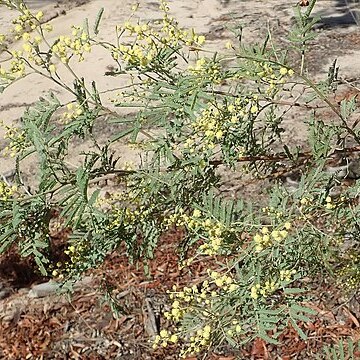Shrub or tree 1.5–7 m high, with a single trunk or usually many-stemmed. Bark smooth, green, grey, brown or brownish purple. Branchlets slightly flattened, acutely angled towards apex, densely appressed-puberulous with grey or yellow hairs to glabrous. Young foliage-tips yellow, golden or rust-coloured, densely puberulous. Leaves coriaceous, dark or light green; petiole above pulvinus 0.4–3 cm long, flattened vertically, densely grey-or golden-puberulous, with a large gland to 5 mm below basal pinnae; rachis (0.7–) 1.5–6.5 cm long, flattened vertically, with depressed oblong or spherical grey-puberulous jugary glands at base of all or most pairs of pinnae, often with 1–3 often contiguous, interjugary glands between some or all pairs of pinnae; pinnae (1–) 3–12 pairs, 0.7–6.5 cm long, with lower pairs slightly smaller than others; pinnules (7–) 11–32 (–45) pairs, widely spaced, linear to narrowly oblong, 1–12 mm long, 0.4–1.3 mm wide, with upper surface glabrous or slightly puberulous and lower surface with appressed golden or white hairs or glabrous, broadly rounded or truncate apically. Inflorescences in axillary racemes, or terminal or axillary false-panicles. Peduncles 1–5 (–7) mm long, normally with golden to whitish appressed hairs. Heads globular, yellow to cream-coloured, 15–30-flowered. Pods linear to narrowly oblong, slightly to deeply and often irregularly constricted between seeds, 3.5–18 cm long, 5–12 mm wide, coriaceous, black or dark brown, smooth or slightly rough, with appressed grey, yellow or fawn hairs, later glabrescent.
More
Small, unarmed tree or shrub to 6 m. Branchlets slightly ribbed and as the young shoots and inflorescences with a yellowish indumentum of dense appressed hairs. Leaves bipinnate, rachis and pinnae with moderate to dense appressed indumentum, rachis 3-5.5 cm, petiole 1-1.5 cm, rachis glands at or slightly below the junction of the pinnae, thickly rimmed, 1 or 2 extra glands occasion-all} between the junctions; pinnae 6-12 pairs, 1.5-3 cm; leaflets opposite, sessile, 18-30 pairs, oblong-linear, 2.4-3(-4) by 0.6-1 mm, thick, obt ise, upper surface glabrous, lower usually densely appressed puberulous. Inflorescences consisting of 20-25-flowered heads, aggregated into 4-14 cm panicles. Pods linear, flat, slightly concave ovt r the seeds, c. 10 by 0.5 cm, with an indumentum of short appressed white hairs, funicle expanded Into a cupular aril below the seed.
A shrub. It can be 2-7 m tall. The bark is smooth. The small branches can be angled and have white hairs. The leaves are 1-3 cm long. The flowers are in groups at or near the ends of branches. The heads are round and have 15-30 flowers. They are cream to yellow. The pods are straight or curved. They are constricted between the seeds. The podsvare 4-18 cm long by 6-11 mm wide.
Details on the utilisation of Acacia deanei are given in G.M. Cunningham et al., Plants of Western New South Wales 359–360 (1981) and J.C. Doran et al., in J.C. Doran & J.W. Turnbull (eds), Australian Trees and Shrubs: Species for Land Rehabilitation and Farm Planting in the Tropics 140–141 (1997).
More
The seeds are ground into flour.


